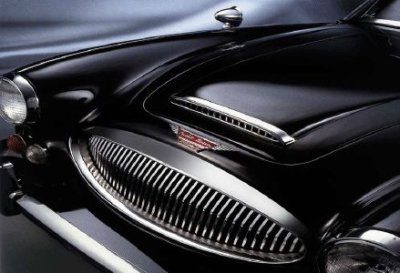articles/Lighting/slickandsexy-page2
Slick and Sexy Dave Montizambert makes a BIG light - part 2 of 1 2
by Dave Montizambert Published 01/04/2008

Size affects intensity - the size of the light source is one of the main determining factors of how bright a specular highlight will appear on a subject's surface. If you decrease the size of a light source, the resulting specular highlights will occupy a proportionally smaller area and will proportionally increase in brightness making them more opaque, allowing less or none of the subject's surface to show through. If you increase the size of a light source, the resulting specular highlights will occupy a proportionally larger area and will proportionally increase in brightness making them less opaque and more translucent, allowing more of the subject's surface to show through.
It works like this: a smaller light source scrunches all of the light energy to a smaller area and so the reflection of that small light source on the surface of the subject will then appear brighter because the energy occupies less area. A larger light source spreads the available light energy over a bigger area and so the reflection of that larger light source on the surface of the subject will then appear less bright because the light energy is spread over a larger area. Kind of like a small swimming pool with 1,000 gallons of water in it compared to 1,000 gallons in a larger swimming pool - the water level in the smaller pool will be deeper (brighter) and the larger pool the water level will be less deep (less bright).
To create the beautiful specular highlights on the car hood, an 18 foot by 30 foot reflector was suspended with nylon cord above the car, just out of the camera frame (see Image 2). The frame of the reflector was constructed from lightweight but very strong aluminum tubing called Ultimate Support from the makers of Chimera soft-boxes. To construct the huge reflector light source two 9 x 40 foot rolls of white seamless paper were unrolled onto the floor side by side. The two rolls were overlapped a little and then taped together with clear packing tape. Ten feet of paper was trimmed off one end leaving an18x30foot rectangle of white seamless paper. The frame was placed on top of the paper and then secured to the paper with more clear packing tape. The white paper made an excellent and inexpensive reflector with very neutral colour balance
Two 1,000 watt inexpensive tungsten stage spotlights with Fresnel lens were positioned on the floor near the car and were pointed up at the underside of the reflector panel. The lights were adjusted to create soft-edged puddles of light on the paper. The reflection of these light-puddles can be seen all over the top of the car - notice how they appear bright in the centre and fall off gradually to dark; this gradation was caused by the Fresnel lens.
To add specular highlights to the frontal chrome-work that was off-angle to the top light-source, a 10x6.5 foot panel with two layers of white nylon stretched over it was placed on the floor in front of the Healy. A third tungsten light (500 watt) was placed on the opposite side of the panel and set to fire directly through the white nylon.
To create odd sweeping light patterns on the wall behind the Healy, light from a second 500 watt tungsten light was reflected off a bent and twisted Plexiglas mirror.
When shaping an object/subject with specular highlights, be aware that they are angle sensitive and so must be viewed from the camera angle. I spent considerable time staring through the camera lens while an assistant tweaked the position of the lights so that the specular highlights sat on the car right where I wanted them - sweet and sexy.
Camera: Hasselblad ELM with Sinar 54H digital back
Lens: Hasselblad/Zeiss 50mm
Exposure: f16 for 32 seconds @ 50 ISO single shot mode
Dave Montizambert
Dave Montizambert lectures internationally on lighting, digital photography and Photoshop. He is also a published author having written two books on lighting and digital photography plus numerous magazine articles on these topics in North America and in Europe. Dave also creates Photoshop tutorial DVDs for www.software-cinema.com, http://www.software-cinema.com/ and is a beta tester for Adobe Photoshop
Please Note:
There is more than one page for this Article.
You are currently on page 2
- Slick and Sexy Dave Montizambert makes a BIG light page 1
- Slick and Sexy Dave Montizambert makes a BIG light page 2
1st Published 01/04/2008
last update 09/12/2022 14:59:01
More Lighting Articles
There are 12 days to get ready for The Society of Photographers Convention and Trade Show at The Novotel London West, Hammersmith ...
which starts on Wednesday 14th January 2026





